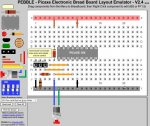Snowghost Project- Pulsin- Tacho- LCD-
Hey All, thanks in Advance for posting, reading, and helping me out.
i have taking up the project of making a Tachometer for my car, as my school project.
i am using the ECU output of my car, a picaxe18x, and an LCD display.
My questions here will be in Parts, as i am trying to do as much of this project as i can and learn as much as i can by my self.
my apologizes for earlier confusing and messy posts.
_____________________________________________________________
Question 1) - Downloading to picaxe18X
i have been unable to get the chip to download because of some hardware fault. (byte 255 problem from memory?)
this fault comes up some point near the start of the download, 1 or 3 download bars in.
the chip is new (defiantly an 18X, and on correct download settings)
download cable fine (tested with an 08M download)
power supply fine (bench PSU )
this leads to the reset pin on the 18X (floating?)
it is tied high with the 4k7.
the only thing missing from my download board is the rest button, as i presume it is a jumper from pin 4 to ground?
the board is on a breadboard, ive remade it twice, and its been checkd over by a classmate.
so please, any ideas? this is first time with the 18X
___________________________________________________
Question 2) - Using Pulsin commands.
im going to use the Pulsin command to count the pulse width coming out from the ECU of the car.
what would be a safe/suitable voltage to use, to read the pulse width with?
(i can not find this in a manual)
thanks very much!
Snowy
Hey All, thanks in Advance for posting, reading, and helping me out.
i have taking up the project of making a Tachometer for my car, as my school project.
i am using the ECU output of my car, a picaxe18x, and an LCD display.
My questions here will be in Parts, as i am trying to do as much of this project as i can and learn as much as i can by my self.
my apologizes for earlier confusing and messy posts.
_____________________________________________________________
Question 1) - Downloading to picaxe18X
i have been unable to get the chip to download because of some hardware fault. (byte 255 problem from memory?)
this fault comes up some point near the start of the download, 1 or 3 download bars in.
the chip is new (defiantly an 18X, and on correct download settings)
download cable fine (tested with an 08M download)
power supply fine (bench PSU )
this leads to the reset pin on the 18X (floating?)
it is tied high with the 4k7.
the only thing missing from my download board is the rest button, as i presume it is a jumper from pin 4 to ground?
the board is on a breadboard, ive remade it twice, and its been checkd over by a classmate.
so please, any ideas? this is first time with the 18X
___________________________________________________
Question 2) - Using Pulsin commands.
im going to use the Pulsin command to count the pulse width coming out from the ECU of the car.
what would be a safe/suitable voltage to use, to read the pulse width with?
(i can not find this in a manual)
thanks very much!
Snowy
Last edited:

